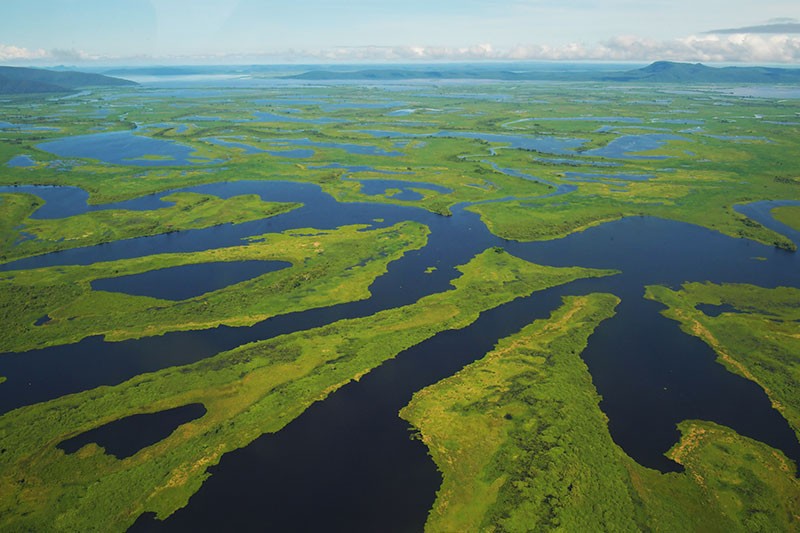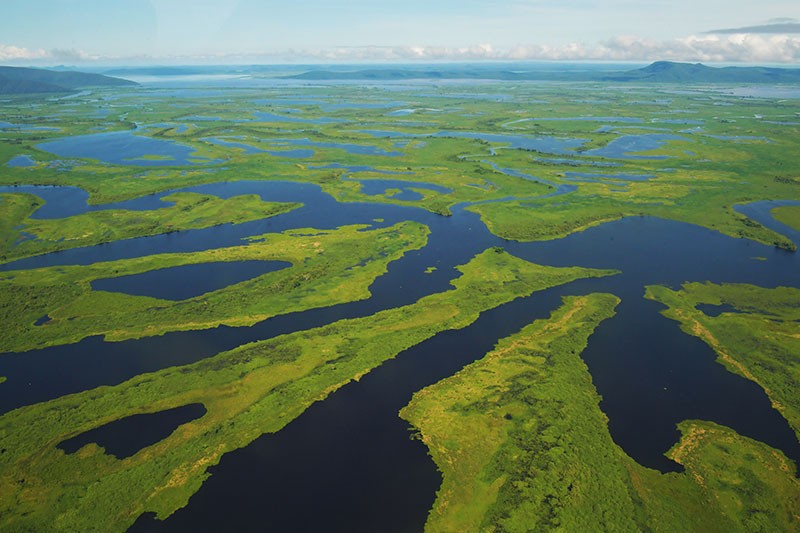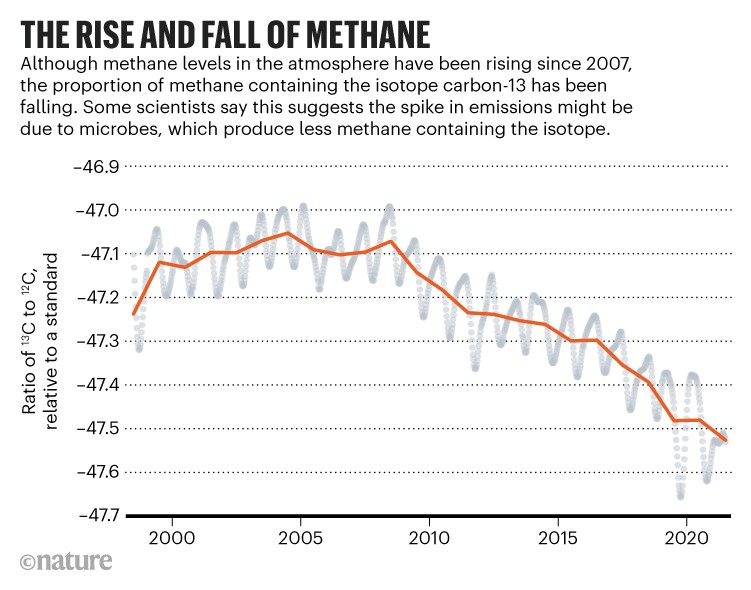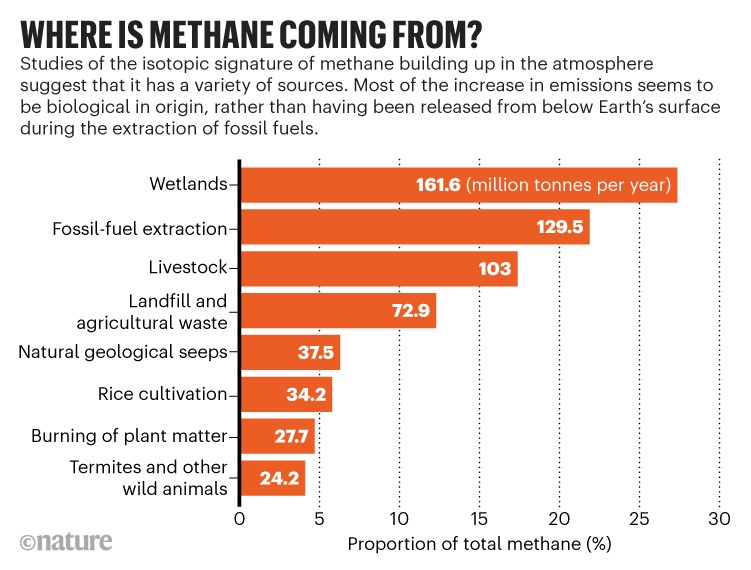Scientists alarmed over fast growth in atmospheric methane
from Nature
As global methane concentrations soar over 1,900 parts per billion, some researchers fear that global warming itself is behind the rapid rise.
Methane concentrations in the atmosphere raced past 1,900 parts per billion last year, nearly triple preindustrial levels, according to data released in January by the US National Oceanic and Atmospheric Administration (NOAA). Scientists says the grim milestone underscores the importance of a pledge made at last year’s COP26 climate summit to curb emissions of methane, a greenhouse gas at least 28 times as potent as CO2.
The growth of methane emissions slowed around the turn of the millennium, but began a rapid and mysterious uptick around 2007. The spike has caused many researchers to worry that global warming is creating a feedback mechanism that will cause ever more methane to be released, making it even harder to rein in rising temperatures.
“Methane levels are growing dangerously fast,” says Euan Nisbet, an Earth scientist at Royal Holloway, University of London, in Egham, UK. The emissions, which seem to have accelerated in the past few years, are a major threat to the world’s goal of limiting global warming to 1.5–2 °C over pre-industrial temperatures, he says.
Source: NOAA
Enigmatic patterns
For more than a decade, researchers have deployed aircraft, taken satellite measurements and run models in an effort to understand the drivers of the increase (see ‘A worrying trend’)1,2. Potential explanations range from the expanding exploitation of oil and natural gas and rising emissions from landfill to growing livestock herds and increasing activity by microbes in wetlands3.
“The causes of the methane trends have indeed proved rather enigmatic,” says Alex Turner, an atmospheric chemist at the University of Washington in Seattle. And despite a flurry of research, Turner says he is yet to see any conclusive answers emerge.
One clue is in the isotopic signature of methane molecules. The majority of carbon is carbon-12, but methane molecules sometimes also contain the heavier isotope carbon-13. Methane generated by microbes — after they consume carbon in the mud of a wetland or in the gut of a cow, for instance — contains less 13C than does methane generated by heat and pressure inside Earth, which is released during fossil-fuel extraction.
Scientists have sought to understand the source of the mystery methane by comparing this knowledge about the production of the gas with what is observed in the atmosphere.
By studying methane trapped decades or centuries ago in ice cores and accumulated snow, as well as gas in the atmosphere, they have been able to show that for two centuries after the start of the Industrial Revolution the proportion of methane containing 13C increased4. But since 2007, when methane levels began to rise more rapidly again, the proportion of methane containing 13C began to fall (see ‘The rise and fall of methane’). Some researchers believe that this suggests that much of the increase in the past 15 years might be due to microbial sources, rather than the extraction of fossil fuels.
Source: Sylvia Michel, University of Colorado Institute of Arctic and Alpine Research
Back to the source
“It’s a powerful signal,” says Xin Lan, an atmospheric scientist at NOAA’s Global Monitoring Laboratory in Boulder, Colorado, and it suggests that human activities alone are not responsible for the increase. Lan’s team has used the atmospheric 13C data to estimate that microbes are responsible for around 85% of the growth in emissions since 2007, with fossil-fuel extraction accounting for the remainder5.
The next — and most challenging — step is to try to pin down the relative contributions of microbes from various systems, such as natural wetlands or human-raised livestock and landfills. This may help determine whether warming itself is contributing to the increase, potentially via mechanisms such as increasing the productivity of tropical wetlands. To provide answers, Lan and her team are running atmospheric models to trace methane back to its source.
“Is warming feeding the warming? It’s an incredibly important question,” says Nisbet. “As yet, no answer, but it very much looks that way.”
Regardless of how this mystery plays out, humans are not off the hook. Based on their latest analysis of the isotopic trends, Lan’s team estimates that anthropogenic sources such as livestock, agricultural waste, landfill and fossil-fuel extraction accounted for about 62% of total methane emissions since from 2007 to 2016 (see ‘Where is methane coming from?’).
SOURCE: Ref. 5.
Global Methane Pledge
This means there is plenty that can be done to reduce emissions. Despite NOAA’s worrying numbers for 2021, scientists already have the knowledge to help governments take action, says Riley Duren, who leads Carbon Mapper, a non-profit consortium in Pasadena, California, that uses satellites to pinpoint the source of methane emissions.
Last month, for instance, Carbon Mapper and the Environmental Defense Fund, an advocacy group in New York City, released data revealing that 30 oil and gas facilities in the southwestern United States have collectively emitted about 100,000 tonnes of methane for at least the past three years, equivalent to the annual warming impact of half a million cars. These facilities could easily halt those emissions by preventing methane from leaking out, the groups argue.
At COP26 in Glasgow, UK, more than 100 countries signed the Global Methane Pledge to cut emissions by 30% from 2020 levels by 2030, and Duren says the emphasis must now be on action, including in low- and middle-income countries across the global south. “Tackling methane is probably the best opportunity we have to buy some time”, he says, to solve the much bigger challenge of reducing the world’s CO2 emissions.
doi: https://doi.org/10.1038/d41586-022-00312-2
UPDATES & CORRECTIONS
-
Correction 08 February 2022: An earlier version of this story said that bacteria generate methane in wetlands and the guts of cows. Methane is emitted by microbes in these places.
References
-
Nisbet, E. et al. Phil. Trans. R. Soc. A. https://doi.org/10.1098/rsta.2021.0112 (2021).
-
Palmer, P. I. et al. Phil. Trans. R. Soc. A. https://doi.org/10.1098/rsta.2021.0106 (2021).
-
Turner, A. J., Frankenburg, C. & Kort, E. A. Proc. Natl Acad. Sci. USA 116, 2805–2813 (2019).
-
Ferretti, D. F. et al. Science 309, 1714–1717 (2005).
-
Lan, X. et al. Global Biogeochem. Cycles https://doi.org/10.1029/2021GB007000 (2021).





